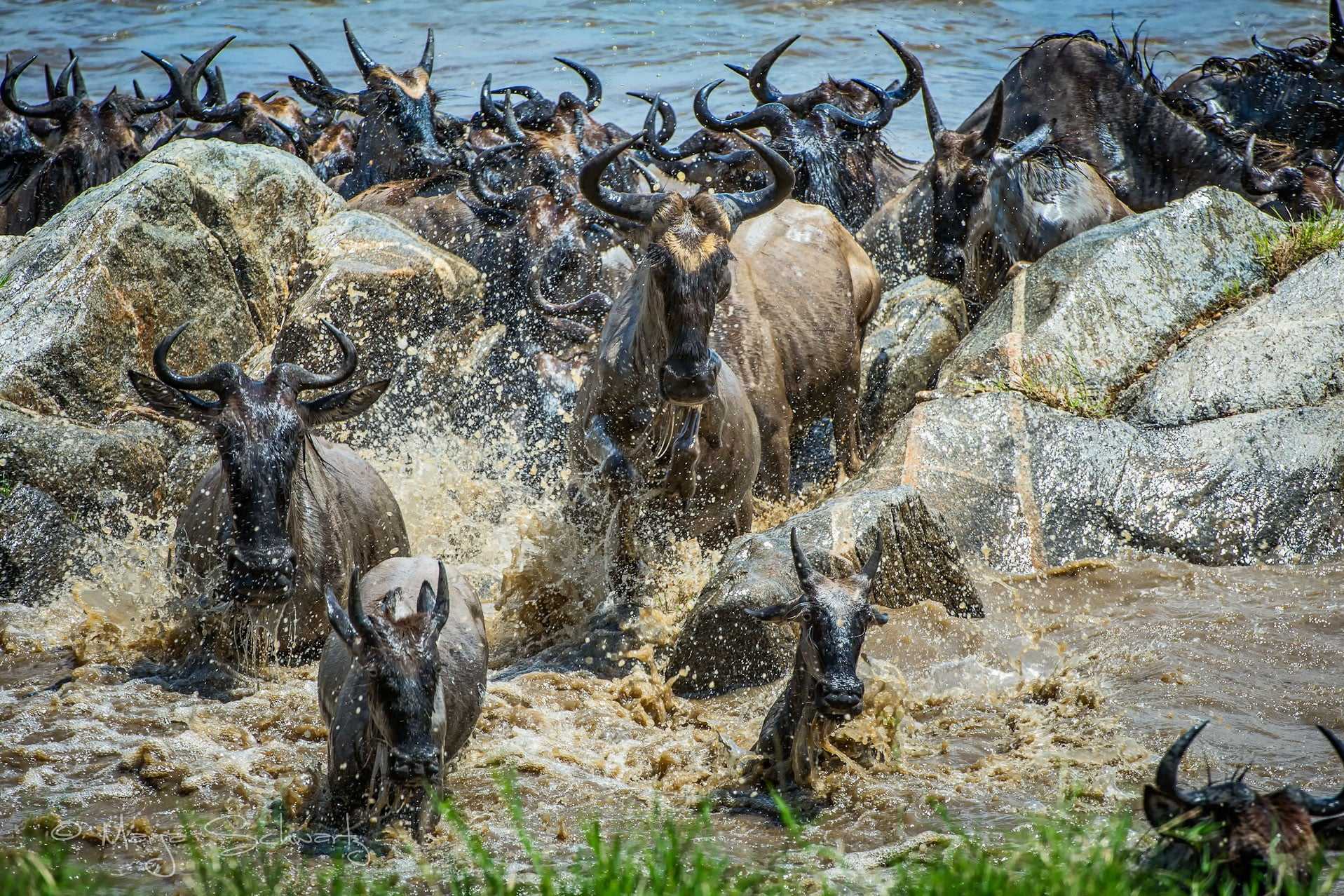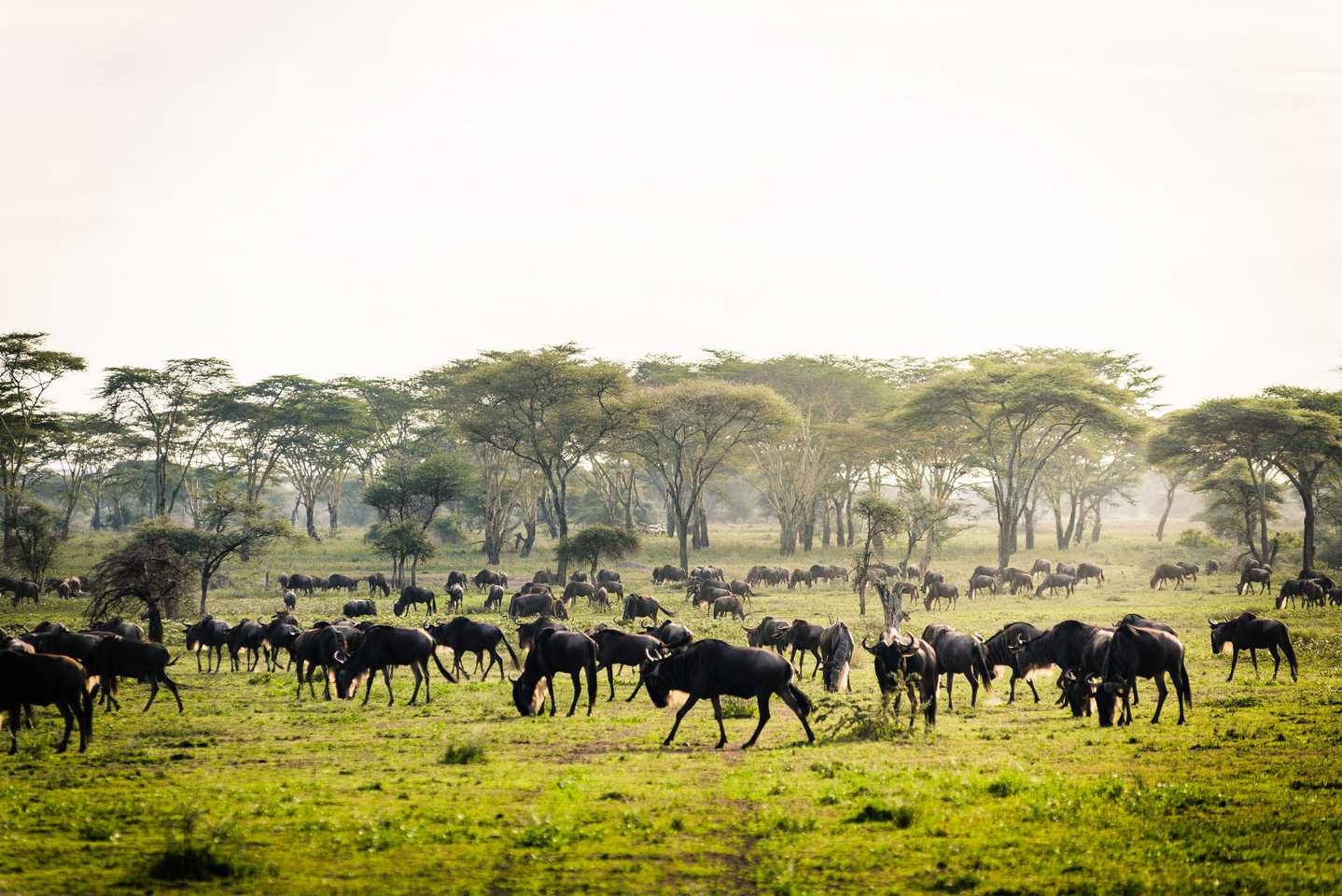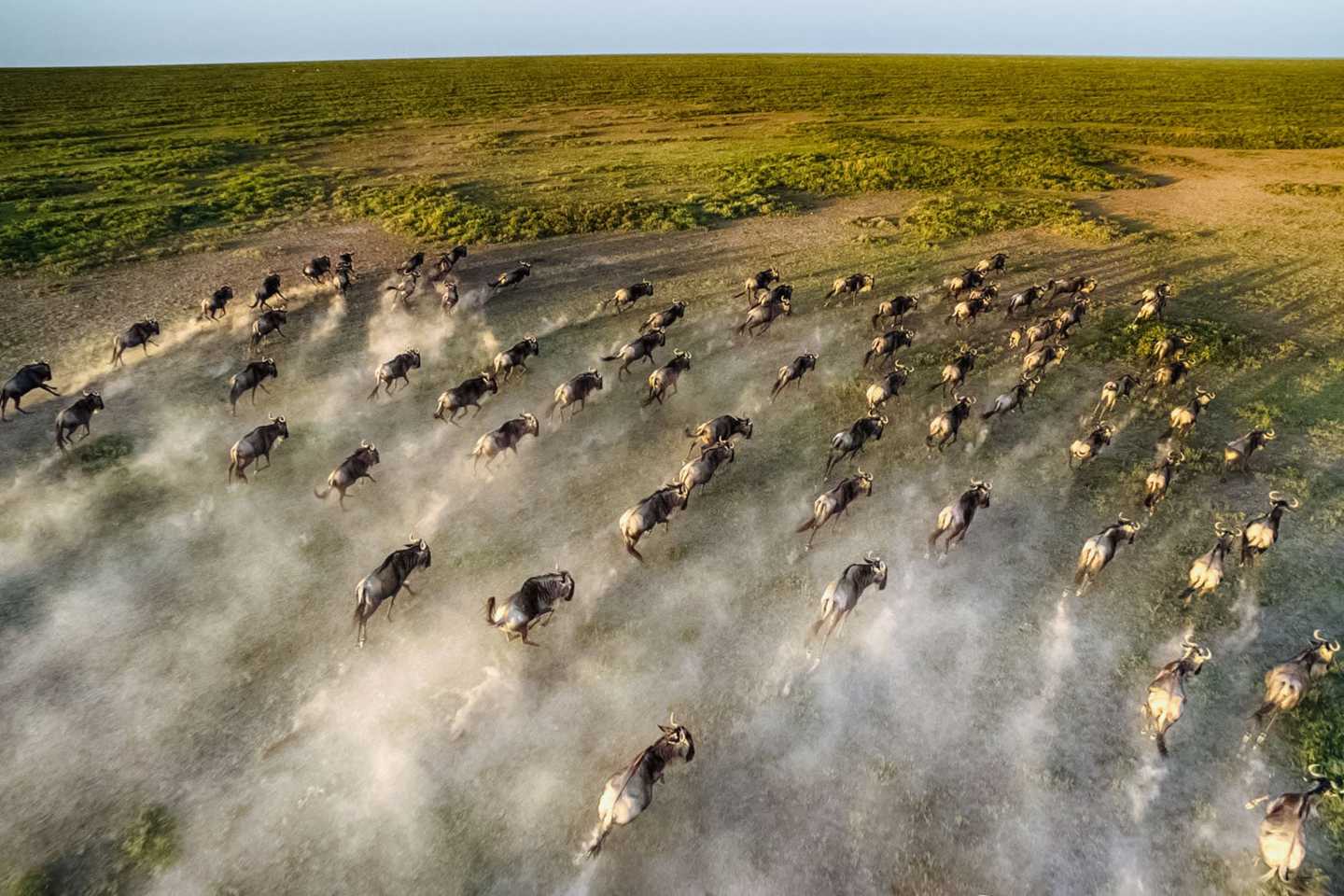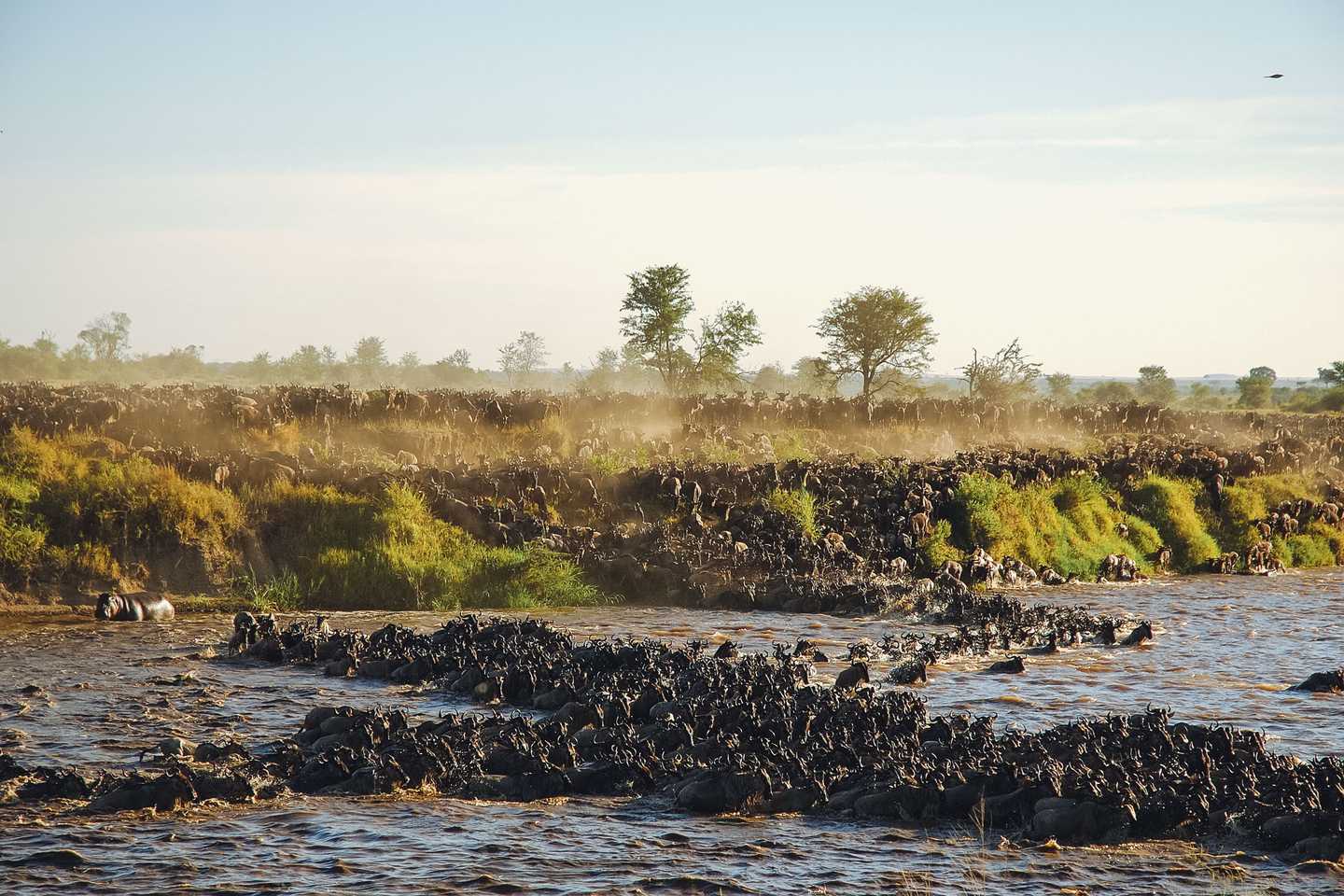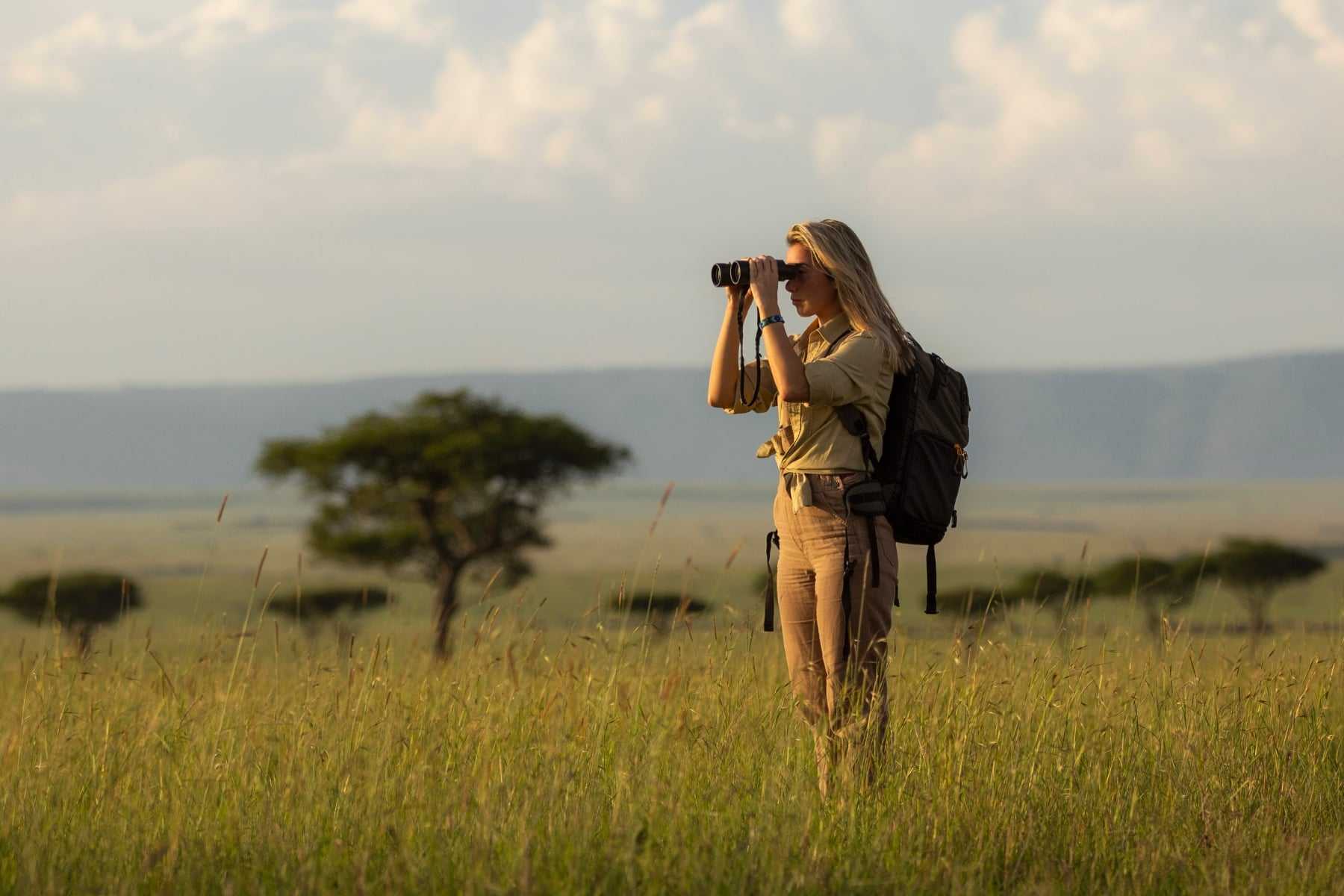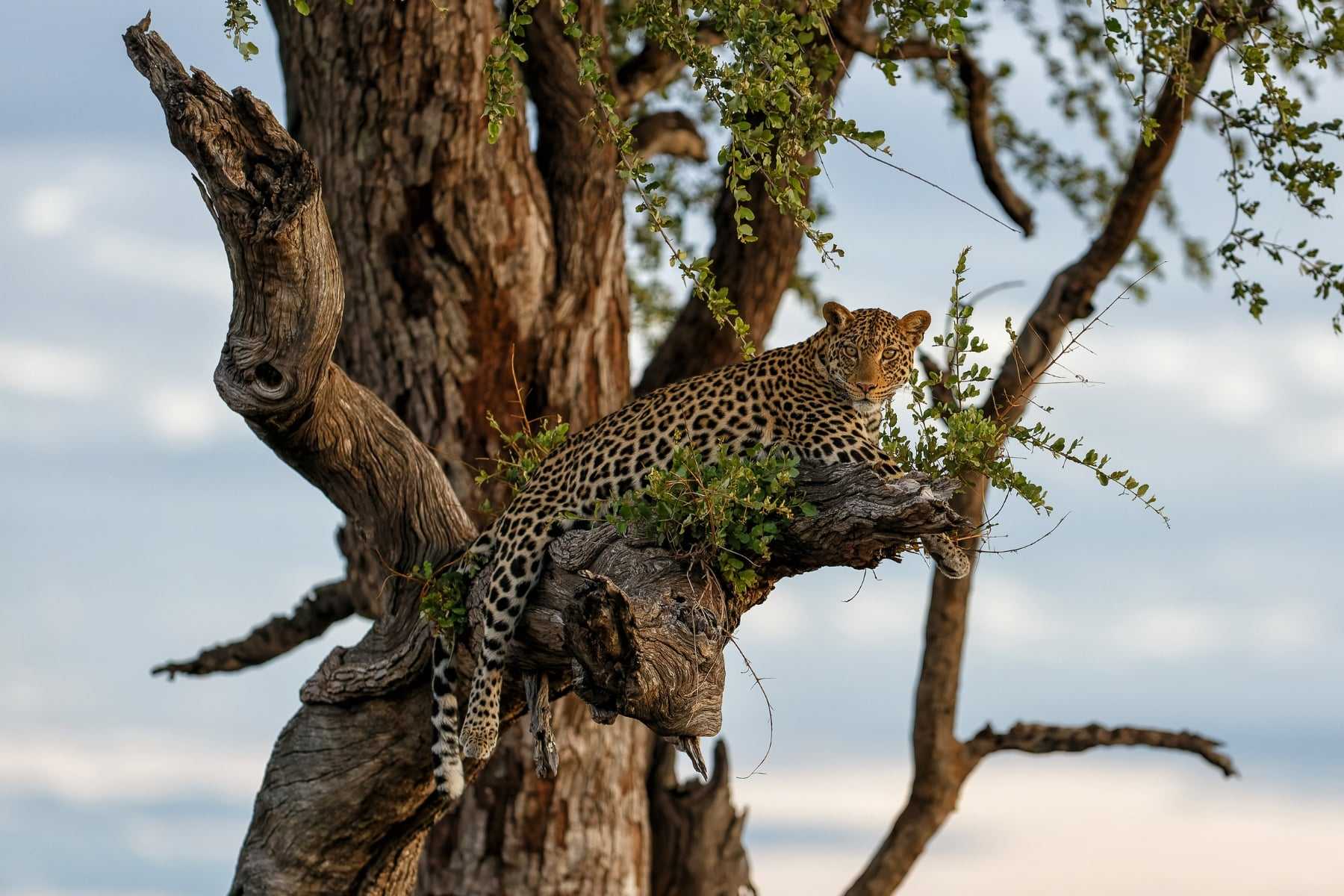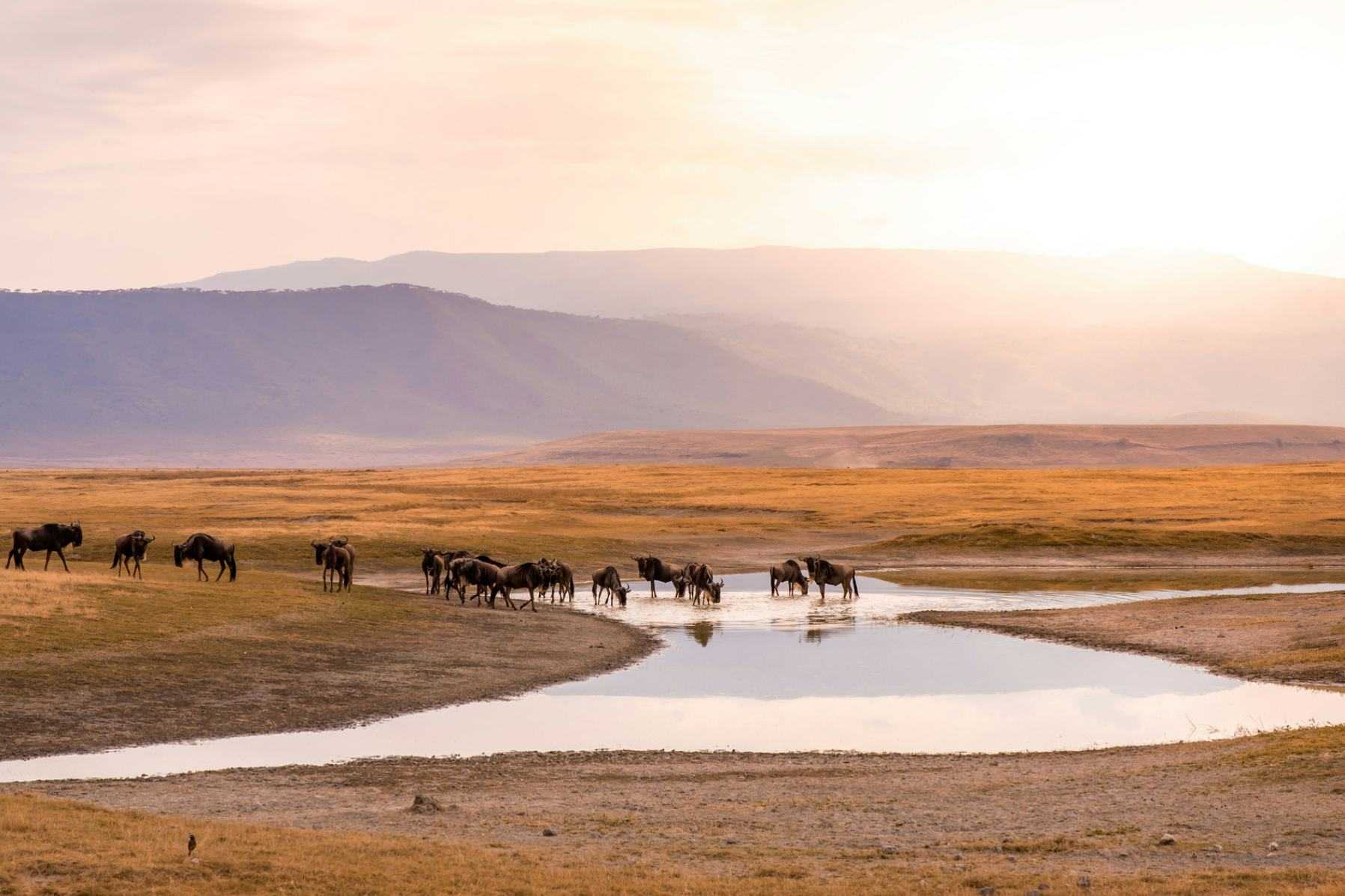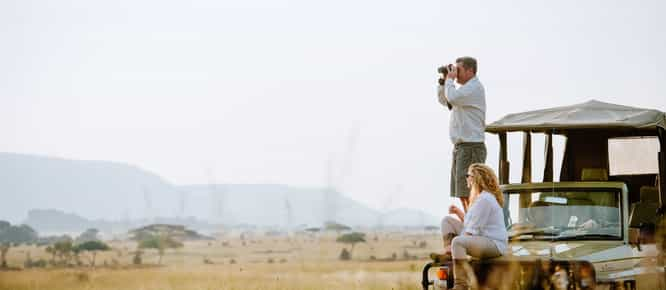The Great Wildebeest Migration Explained
The great wildebeest migration: Africa’s greatest wildlife show and in fact the largest mass movement of mammals anywhere on the planet. With such a claim to fame, it’s an extravaganza that tops many a wildlife-lover’s travel list and thousands of people flock to Kenya’s Masai Mara and Tanzania’s Serengeti every year to see the herds of ‘beests.
We’ve written before on this blog about why the great wildebeest migration actually occurs here (thanks to our resident wildlife expert Paul Steyn for that one), given a brief overview of what the gnus are up to at what time of year here, and picked out some of our favourite migration-watching camps here. But this is our all-singing, all-dancing guide to the great wildebeest migration. It’s a one-stop shop for all the information you’ll need for the month you decide to travel in, what the weather’s doing, plus some of our hot tips to make the most of your migration safari. To get things started, our first Timbuktu Tip is that there’s not strictly a ‘migration season’, as those not in the know like to talk about. The great wildebeest migration is an eternal cycle and the beasties don’t simply vanish for half the year. They are always there – you just have to know where to look…
December to March
The calving season
By December, the lure of the rains and a taste for fresh, sweet grass leads the wildebeest to gather on the southern plains of Tanzania’s Serengeti National Park. It’s said that wildebeest can smell rain in the air from thousands of kilometres away and as the skies begin to darken with heavy clouds, they slowly make their way through the eastern areas of the park and into the south. You know those iconic photographs that grace the cover of National Geographic of the vast, emerald-green plains dotted with throngs of animals? Well, that’s happening right now.
You might notice something else at this time of year too – some rather plump looking wildebeest! The majority of female gnus are preparing to give birth and after a feast of nutritious grass in January, birthing season begins in earnest in February and March. The fertile females usually drop their young within a few weeks of each other and the plains heave with almost half a million new, fluffy lives (really!). It’s an incredible spectacle to witness, but prepare for some gory scenes too for the predators are never far away and it’s almost as if they know they’ll have easy pickings from the young…
What’s the weather doing?
You might have guessed it already, but December to March is typically a rainy time in Tanzania. Tanzanians know them as ‘short rains’ and the showers are at their heaviest in December and at the beginning of January, but even in these months it’s nothing a waterproof jacket and a vehicle with a roof won’t fix. It’s rare that you’ll have to miss a game drive because of the weather and even if you do, make the most of the spectacular storms with a cup of tea and a slice of cake back at base. By mid-January, the rains lessen and Tanzania enters a mini dry season so if you have dreams of a blue-sky-filled Great Wildebeest Migration safari, don’t shun this time of year and the magic of the calving season just yet (but do still bring a rain jacket, just in case).
Where should I stay?
Many of the camps on the southern Serengeti plains are mobile tented camps. This simply means that they move around the Serengeti alongside the wildebeest and will always be in the best place at the best time. And mobile doesn’t mean roughing it: we’ve got brass bathtubs, butler service and all the bells and whistles if you want it – and plenty of choice if you don’t.
Serian’s Serengeti Mobile Kusini, Tanzania
It might one of the more expensive options in the south, but Serian’s Serengeti Mobile is worth every penny thanks to its elegant décor, stunning setting and legendary guide, Alex Walker, who knows just about everything possible about the Great Wildebeest Migration.
View lodge
Sanctuary Kichakani Serengeti Camp, Tanzania
A relatively new addition to the southern migration circuit, Sanctuary Kichakani is a little gem that’s had rave reviews since opening. Stay here for earthy luxury in a perfectly-selected location for the herds, and leave knowing that you’ve left not a trace on the environment.
View lodge
Olakira Camp, Tanzania
Located in the exclusive Ndutu region (which is also well-known for its leopard population, if you can tear your eyes away from the gnus), Olakira is a well-established migration camp where the wildebeest have even been known to wander between the tents.
View lodge
Timbuktu Top Tip
Forget the rumours that say you can only see the Great Wildebeest Migration from July to October, for this really is a lovely time of year to travel. Glossy plains and vibrant skies make for beautiful landscapes and the calving is a real once in a lifetime event.
April to mid-June
The trek north and the mating season
As the rains come to an end in the southern Serengeti and the grasses start to dry and shrivel, the beasties start to think about their next destination: the north. Again, it’s the lure of that fresh grass that sends them on their way and throughout this middle section of the year, you’ll spot mega-columns of wildebeest, stretching all the way from the southern plains through the central section of the Serengeti and into the west as they begin the mammoth trek.
Interestingly, wildebeest have no leader and the herd will often split into smaller groups that fork off and wander in different directions. This is most true at this time of year, which is why you’ll hear and see different recommended locations for migration-viewing in April, May and June (who said nature was straightforward?). Generally-speaking however, April and the beginning of May see the beasties congregating in the central areas of the Serengeti around the Moru Kopjes, and if you’re lucky, you’ll spot the battling males as they fight fiercely for a mate. By the end of May, most of the herds will have reached the Western Corridor of the Serengeti and the Grumeti Reserve. It’s here that they gather on the banks of the Grumeti River to face the first real challenge of the trek: crossing the water. Whilst these river crossings aren’t quite up to the thrashing, smashing, life-altering spectacle of the Mara River in the north, it’s still quite a scene to see the wildebeest hurtling through crocodile jaws and navigating the pools and channels of the river.
What’s the weather doing?
Tanzania enters the ‘long rains’ around April and they continue into May so this is a wet time of year. Some of the mobile camps may close as the ground isn’t solid enough, so choose your accommodation carefully and make sure to book in advance (more about accommodation coming up shortly). Our advice? Don’t discount this time of year at all. As with rainfall patterns all over the world, Tanzania’s rains are difficult to predict and almost every year, storms are sandwiched between beautiful, sunshine-filled days. If this is the time of year that you would like to travel, pack a raincoat, a waterproof bag for your camera and go, go go!
Where should I stay?
There is an enormous amount of accommodation available across the central Serengeti, ranging from authentic, under-canvas mobile camps to permanent lodges with more than a touch of class. There is markedly less available in the western Serengeti, but this in turn makes the Grumeti Reserve and surrounding plains one of the most exclusive areas in the national park.
Kiota Camp, Central Serengeti
Simple, unpretentious and lovely, Kiota is set slightly further away from other camps in the busy central area of the park but still guarantees a good chance of spotting the gnus, alongside some good, old-fashioned Tanzanian hospitality.
View lodge
Dunia Camp, Central Serengeti
Not only is Dunia Camp Tanzania’s first all-women camp (big thumbs up from us!) it’s also in a superb position, smack-bang in the heart of the Serengeti in an area that’s known for its year-round game viewing and wonderful wildebeest-watching.
View lodge
Ubuntu Migration Camp, Western Serengeti
A good choice for May or June, Ubuntu is a mobile camp of the rustic, charming variety. It’s an intimate place where guiding is the main focus, and boy do the team know their way around the wildebeest. Expect fantastic migration-viewing and the best service you’ll ever experience.
View lodge
&Beyond Grumeti Serengeti Tented Camp, Western Serengeti
Open year-round, the Grumeti Serengeti Camp is a good permanent option in the Grumeti area. Start your day with a cup of steaming coffee overlooking the river, head out for a migration-filled game drive, and retreat back to your bush-chic tent and feather-soft duvet in the evening.
View lodge
Timbuktu Top Tip
The great wildebeest migration is an unpredictable beast (excuse the pun!), and there’s never a guarantee where the gnus will be. Take your chances with a safari in the west – even if you’re not visiting at the prime ‘migration time’, chances are you’ll see some wildebeest somewhere along the way…
Mid-June to November
The river crossings
It’s often said that the star of the Great Wildebeest Migration show is the river crossings during which the herds take the leap from Tanzania and into Kenya across the mighty Mara River. These are months of drama and exhilaration, chaos and commotion, and watching the wildebeest plunge across the water is undoubtedly some of the most exciting game viewing you’ll ever witness. Around 250,000 wildebeest die every year during the migration, the majority of them here, as predators roam the banks and crocodiles lie in wait…
In June, most of the herds are plodding towards the river and beginning to gather on the northern plains of the Serengeti. The action really gets going in July when the first crossings take place and the watery stampede continues into August and September when the wildebeest regroup for a short breather on the Masai Mara side of the river. The drama isn’t over yet for the poor gnus, however, for they must return from whence they came: Tanzania. And so, in October, the action starts up again as the wildebeest face the second crossing of the Mara River and back to the northern plains of the Serengeti. As November rolls around, so do the thunderclouds in the distance and with a sniff of the air and stamp of the ground, the wildebeest are off to find the fresh, green shoots of the south. Thundering through the eastern section of the Serengeti and flooding the central area once again, the beasties arrive safely back in the southern Serengeti in December – and the cycle is complete.
What’s the weather doing?
June to November is considered the dry season in Tanzania (and Kenya!) and picture-perfect, cloudless skies and plenty of sunshine are the name of the game. June and July are the coldest months in East Africa and mornings and evenings in particular can be a touch chilly so a scarf and gloves won’t go amiss in the dawn chill. From August, the temperatures get steadily hotter until November when the spell is broken by the first of the rains. Iconic weather and iconic game viewing? Sounds like a pretty good time to visit!
Where should I stay?
The northern Serengeti and Masai Mara regions are probably some of the most popular in Africa and accommodation is plentiful and superb. There’s everything from movable tented camps and simple, genuine lodges to the swankiest of retreats, just made for a spot of R&R. In this peak migration season, however, the areas both get busy and we cannot stress enough just how far in advance you should book to secure the top spots.
Lamai Serengeti Camp, Tanzania
Peaceful and serene, Lamai Serengeti is a permanent camp in one of the quieter (of people that is, not wildlife!) areas on the northern plains. Expect top-notch migration viewing on game drives and well thought out touches that will make your stay extra special.
View lodge
Chaka Mobile Kogatende, Tanzania
Take things back to basics at Chaka Mobile and add a touch of adventure to your migration safari. The eight tents occupy an excellent, wildebeest-watching position in the northern reaches of the Serengeti and hot bucket showers and late nights around the campfire will propel you back to the safari days of old.
View lodge
Governor’s Camp, Kenya
One of the Masai Mara’s oldest camps (and still one of the best, in our opinion!), Governor’s has been taking guests to the heart of the migration for years and the whole experience, hot air balloon safaris and all, is truly excellent.
View lodge
Rekero Camp, Kenya
Located on the Talek River, a tributary of the main Mara River, Rekero is often the first camp to see the wildebeest as they make the journey into Kenya. The nine charming tents are all spaced along the water too so you’ll see the gnus from just about every corner of camp.
View lodge
Namiri Plains, Tanzania
If November is your chosen month for a great wildebeest migration safari, head to Namiri Plains in the eastern Serengeti to catch the herds on their return journey. The area is exclusive, discreet and famous for some of the best big cat sightings in the entire park.
View lodge
Timbuktu Top Tip
As well as a fabulous month to catch the gnus plunging across the river, October is also one of our favourite months to visit the Masai Mara generally, and avoid the crowds. It’s much quieter outside school holidays, the weather is beautiful and the predators are on top form!
